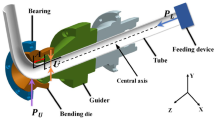Abstract
Longitudinal bending deformation, often induced during gas metal arc welding of long pipe structures, plays a negative role in the accuracy of assembly, external appearance, and various strengths of welded pipe components. In this paper, an experimental and numerical study of pipe welding distortion is presented. A 3D thermo-elastic-plastic finite element model for multi-seam welds (composed of longitudinal (L-seam) and circumferential (C-seam) welds) of pipe components was developed to predict longitudinal bending deformation. The finite element method and experimental results demonstrate good agreement. Therefore, the proposed model can accurately predict welding distortions in multiseam welded pipe structures. Moreover, the results reveal clear distinctions between the longitudinal bending deformations induced by L-seam and C-seam welds due to different selfrestraint strengths. Finally, another characteristic, the bending angle, is analyzed. Linear and nonlinear relationships are observed between the sine of the bending angle and weld length for L-seam and C-seam welds, respectively.
Similar content being viewed by others
References
B. S. Kong and D. K. Park, Design optimization of the cowl cross bar-light cowl cross bar satisfying 5 performances, International Journal of Automotive Technology, 19 (2) (2018) 387–391.
M. E. Qureshi, Analysis of residual stresses and distortions in circumferentially welded thin-walled cylinders, Ph.D. Thesis, National University of Science and Technology (2008).
D. Deng and H. Murakawa, Prediction of welding distortion and residual stress in a thin plate butt-welded joint, Comput. Mater. Sci., 43 (2) (2008) 353–365.
D. Deng, L. Wei and H. Murakawa, Determination of welding deformation in fillet-welded joint by means of numerical simulation and comparison with experimental measurements, J. of Mater Proc. Tech., 183 (2007) 219–225.
M. Abid, M. Siddique and R. A. Mufti, Prediction of welding distortions and residual stresses in a pipe-flange joint using the finite element technique, Modelling Simul. Mater. Sci. Eng., 13 (2005) 455–470.
N. U. Dar, E. M. Qureshi and M. M. I. Hammouda, Analysis of weld-induced residual stresses and distortions in thin-walled cylinders, J. of Mech. Sci. Tech., 23 (2009) 1118–1131.
H.-J. Yi, J.-Y. Kim, J.-H. Yoon and S.-S. Kang, Investigations on welding residual stress and distortion in a cylinder assembly by means of a 3D finite element method and experiments, J. of Mech. Sci. Tech., 25 (12) (2011) 3185–3193.
Y. J. Guan, G. P. Yuan and S. Sun, Process simulation and optimization of laser tube bending, Int. J. Adv. Manuf. Technol., 65 (2013) 333–342.
R. V. Selvan, P. Sathiya and G. Ravichandran, Characterisation of transient out-of-plane distortion of nipple welding with header component, J. of Manuf. Process., 19 (2015) 67–72.
S. K. Velaga, G. Rajput, S. Murugan, A. Ravisankar and S. Venugopal, Comparison of weld characteristics between longitudinal seam and circumferential butt weld joints of cylindrical components, J. of Manuf. Process., 18 (2015) 1–11.
R. Vetriselvan, K. Devakumaran, P. Sathiya and G. Ravichandran, Transient out-of-plane distortion of multi-pass fillet welded tube to pipe T-joints, Defence Technology, 13 (2017) 77–85.
C. Wu and J. Kim, Analysis of welding residual stress formation behavior during circumferential TIG welding of a pipe, Thin Walled Struct., 132 (2018) 421–430.
MSC Software, Marc and Mentat 2016 Installation and Operation Guide, MSC Software Corporation (2016).
J. Goldak, A. Chakravarti and M. Bibby, A new finite element model for welding heat sources, Metallurgical Transactions B, 15 (2) (1984) 299–305.
C. Wang, Y. R. Kim and J. W. Kim, Numerical analysis of thermal deformation in laser beam heating of a steel plate, J. of Mech. Sci. Tech., 31 (5) (2017) 2535–2541.
D. Deng, FEM prediction of welding residual stress and distortion in carbon steel considering phase transformation effect, Materials and Design, 30 (2) (2009) 359–366.
D. Deng, Experimental and numerical investigations of welding distortion induced by CO2 gas arc welding in thin-plate bead-on joints, Materials and Design, 52 (2013) 720–729.
A. Ravisankar, S. K. Velaga, G. Rajput and S. Venugopal, Influence of welding speed and power on residual stress during gas tungsten arc welding (GTAW) of thin sections with constant heat input: A study using numerical simulation and experimental validation, J. Manuf. Process., 16 (2014) 200–211.
Acknowledgements
This research was supported by the project of "development of deformation control smart manufacturing technology for realizing digital cockpit of ultra-lightweight cowl cross" project of the technology development support of the world class 300 project of Ministry of Trade, Industry and Energy & Ministry of SMEs (Small and Medium-sized Enterprises) and Startups.
Author information
Authors and Affiliations
Corresponding author
Additional information
Recommended by Editor Hyung Wook Park
Chunbiao Wu was born in Yangzhou, China. He is currently studying for Ph.D. degree at the Graduate School of Yeungnam University, Korea. His areas of research interests include finite element analysis of residual stress and distortion in welded pipe structures.
Chang-hoon Lee was born in Daegu, Korea. He received B.Sc. degree from Yeungnam University, Korea in 2013. He is currently working at SEWON Corporation, Korea. His work is R&D of plasticity and welding/joint of vehicle structure.
Jae-Woong Kim received his B.Sc. degree from Ajou University, Korea, in 1982. He received his M.Sc. and Ph.D. degrees in Mech. and Production Eng. from Korea Advanced Institute of Science and Technology, in 1984 and 1991, respectively. He is currently a Professor at the School of Mechanical Eng., Yeungnam University, Korea. His research interests include analysis of welded structures, thermal stress and distortion.
Rights and permissions
About this article
Cite this article
Wu, C., Lee, C. & Kim, JW. Numerical simulation of bending deformation induced by multi-seam welding of a steel-pipe structure. J Mech Sci Technol 34, 2121–2131 (2020). https://doi.org/10.1007/s12206-020-0433-8
Received:
Revised:
Accepted:
Published:
Issue Date:
DOI: https://doi.org/10.1007/s12206-020-0433-8



